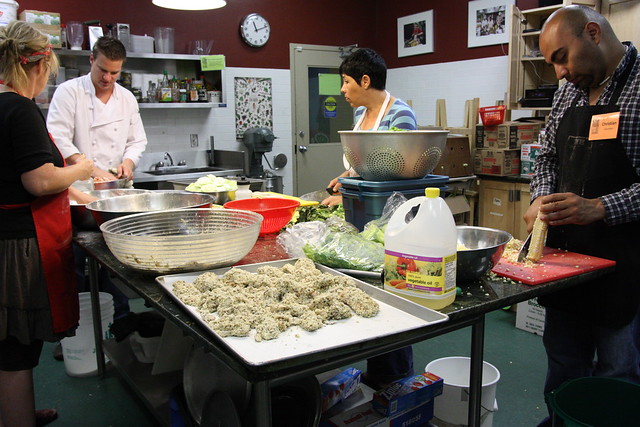
This regular online series will feature interviews with fascinating and influential urban thinkers, with a focus on discussing how Toronto can become a more engaged, accessible, and sustainable city.
In this latest installment of our series on local “food-fighters”, Spacing interviews Nick Saul, the executive director of the Stop Community Food Centre. Serving the West Davenport area, the Stop has developed its own unique program of alleviating hunger in low income communities. In this interview, Saul discusses some of the Stop’s broader community objectives.
Spacing: What does a “Community Food Centre” do differently from a traditional food bank?
Saul: Moving beyond straightforward food banking has been a foundational piece our work at the Stop. Over the last decade, we devised a new, programmatic response to help low income communities, which speaks to people’s agency and dignity. It’s a response we hope also connects both urban and rural and the lower and middle classes.
There’s our community kitchen for example. People told us they didn’t want to be treated as just passive recipients of food charity. Kitchens are a very obvious way people can participate, learn and feel less isolated. It’s through these kitchens that the Stop also provides healthy meals. I don’t want to over-romanticize this, but it’s food that’s cooked with a lot of love. Community members can feel that love and sense that someone put effort into providing them with really good food. That often translates into a feeling of “I matter.” Afterward, people are motivated to get involved by either volunteering or becoming a cook. Beyond that, they may consider working on a civic engagement campaign.
The Stop also runs a community garden. In 1998, a fellow from the parks department let us know about an unused bocce court in Earlscourt Park and asked if we were interested in doing a garden. Community members in west Davenport responded by creating a garden that is now 8000 sq. feet in size. Like the kitchens, its a place for people to participate, and feel valued in a way that’s not just, “here’s your food!”
We DO run a food bank. I wanted to close it when I first arrived but, in retrospect, it was the right decision not to because it would have done more immediate harm than good. Instead, we’ve endeavoured to make sure that we run a very good food bank where you’re not just getting corporate throw-aways when you get a hamper of food. Most food in the food bank sector isn’t particularly nutritious nor culturally appropriate and it’s certainly never enough. If you’re a Somali person, for example, and show up at a typical food bank counter, you probably won’t find grains you’re accustomed to. So we’ve spent a lot of time improving the quality, quantity and cultural diversity of food in our food bank. This means receiving monetary donations so we can purchase quality food. We purchase with our values too: We believe in sustainable farming and a regional food economy, for instance, so we spend a lot of money buying locally-grown food so that farmers can stay on their land while being fairly paid for the work they do.
Spacing: In your mind, what’s wrong with the food bank sector?
Saul: One of the prime motivators in the “community food centre” movement is that food banks aren’t the answer we generally think they are. Aside from issues of food quality, there’s also a social stigma associated with using food banks. At a societal level, food banks divide us as citizens between haves and have-nots and they create a kind of psychological complacency around the issue of poverty. There is a sense that food banks take care of the problem. The reality, however, is that food bank users continue to be the most food insecure people in the country. Fifty to sixty per cent of users don’t know where their next meal is coming from and two or three days out of the week go without food. Food banks create a moral release valve for governments and individual contributors who, for example, puts a tuna-fish can in the grocery store hamper. Each think they’ve done their part but of course there not doing what they purport to do.
Spacing: Is there a political angle to the Stop’s activities?
Saul: Absolutely. Hunger is political. We live in a rich society and we have more than enough resources to fix the problem if it’s prioritized, meaning we must support people when they’re down so they can eventually get back into the economy. My view is that a any good organization has to marry respectful front-line services with speaking out against the structural issues that drive vulnerability. You’re simply not relevant if you don’t. The work we do in our community advocacy program is all about helping our community members find their voice on important issues. The stories people tell are harrowing and they shouldn’t be shamed into silence.
For many, their situation is not their fault—it’s not about poor budgeting, a character flaw or a lifestyle choice. There’s no life or style in poverty and I can’t stand it when I hear a politician stand up and put ‘the screws’ to people who are on low income by denouncing that they haven’t “pulled themselves up by their bootstraps.” The real drivers of vulnerability are frighteningly inadequate social assistance rates, pensions that don’t cover the bills, addiction and mental health issues, or it’s people who were forced to drop out of high school in order to help mom and dad make ends meet. Today’s economy is also dominated by terrible service-sector jobs where you can work 40 hours a week getting minimum wage yet still live below the poverty line!
Statistics demonstrate that 50-55% of people using food-banks are on social assistance or Ontario Disability Support. Because of the meagre amounts they receive, they rely on food-banks. I invite Spacing’s readers to Do the Math and estimate what someone on social assistance should receive. Unless you’re the cruelest bastard in the world, you’re going to come up with a number far exceeding the reveal.
Spacing: How can food bridge class divides?
Saul: Food is not your average commodity. We feel it offers an opportunity to reduce social distancing between classes and that’s why we’ve aimed to create public spaces that connect people who wouldn’t normally associate with one another. The Wychwood Green Barn is an example of such a space. It’s the first time we ever worked in a middle-income community. We want those people to come spend money at the farmer’s market but also want them to know that three kilometres down the road, over 16,000 people a year are coming through the Stop’s emergency relief program.
Farmer’s markets are part of a good-food revolution, which is being lead by the upper and middle classes. It’s based on a notion of consumer change and the idea you can fix the food system if you just buy the right tomato. It’s an intoxicating thought but the problem is that this consumer revolution leaves out vulnerable people who don’t have the resources to participate in it. If you don’t have resources, then you’re stuck buying crappy food wherever you can find it.
We want to catalyze that upper and middle class interest in good food and try to turn the conversation away from “consumer is king” to “citizen is king.” How do we take that genuine passion and interest that exists out there around food and start talking about equity? How do we all sit around the table in this good food revolution? Ultimately it’s about taking that individual, consumer interest around food and bringing it into the public realm. The goal is to transform it into letter writing or lobbying on important issues like disappearing farmland, getting junk food out of schools or increasing social assistance rates. It begins with the basic recognition that food is a public good.
Photo by Sifu Renka




